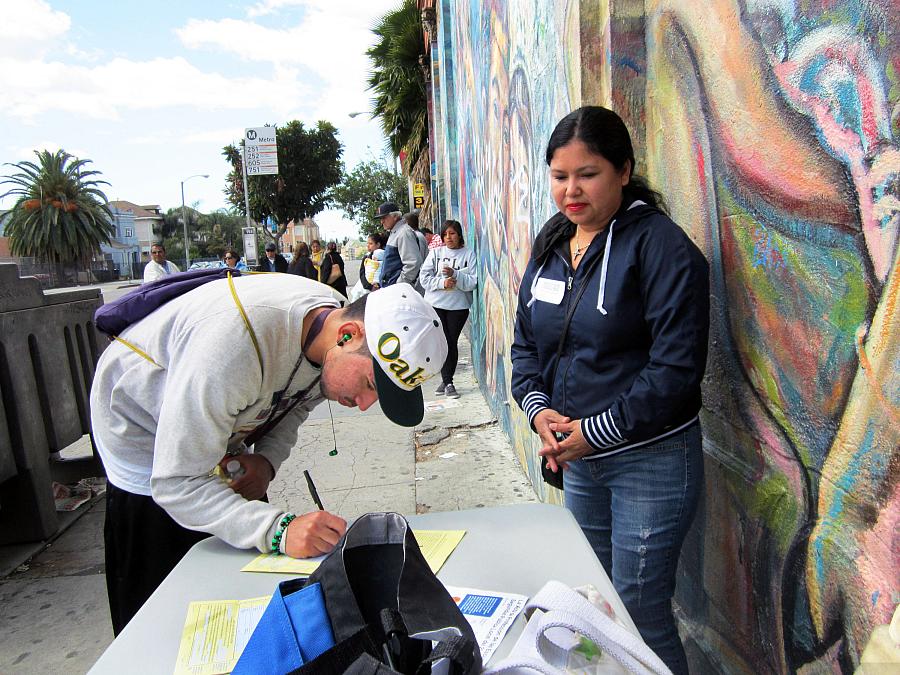Journalistic ‘Missionary Work’ Gives Voice To Underserved Communities

Last weekend, youth reporters in a Latino neighborhood of East L.A. published the latest edition of their community newspaper, Boyle Heights Beat.
The bilingual quarterly publication is distributed to 23,000 homes by La Opinión trucks, reaching most of the nearly 90,000 people living in this densely populated immigrant neighborhood.
For the reporters who produce Boyle Heights Beat, the print newspaper – yes, that’s right, print – represents journalistic missionary work. They’re tired of reading headlines maligning Boyle Heights as a gang haven and a poverty-ridden place. They tell the stories of their community as they see it: conducting intensive research to show a 20-year drop in violent crime here; profiling a “Dreamers” Club that gives hope to undocumented youth and highlighting the stories of loncheras or food trucks, which dotted Boyle Heights’ landscape long before Los Angeles became known as a Mecca for gourmet food truck fare.
“I do feel like Boyle Heights is looked down upon and this publication gives people a different view,” youth reporter Brizette Castellanos, a junior at Theodore Roosevelt High School, told me the other day.
Brizette will share her story December 4 at "Expanding Coverage: News and Information to Enhance Community Health,” a day-long symposium hosted by our USC Annenberg program, The California Endowment Health Journalism Fellowships, in collaboration with The California Endowment and Media Impact Funders. (To see a video on Boyle Heights Beat, click here).
The gathering brings together media and foundation leaders to discuss new models for reporting on underserved communities.
The convening is held in honor of the late Dennis A. Hunt, who co-founded our professional education program for working journalists. We have trained more than 500 journalists nationally since 2005 while providing grants for reporting on health and underserved communities through a fund launched in Dennis’ honor.
Our symposium explores the critical role of media in engaging with and serving marginalized communities. We will learn about creative storytelling approaches, including many supported by philanthropies that give community members a greater voice in civic life.
In a democracy, journalism has the potential to serve the public interest by fostering public engagement, identifying chronic ills, and planting the seeds for positive change. But many journalists are also guilty of “hit and run” journalism. They expose problems in disadvantaged communities and then move on to the next story – without engaging the communities in crafting solutions.
We will be asking whether the conventions of crusading journalism lend themselves to helping make lasting change in underserved communities. What are the best journalism and new media models for doing so? Given the contraction of mainstream journalism and the historically limited resources of community-based media, what new approaches can be most effective, and how can foundations identify and support them?
Boyle Heights Beat, a collaboration of our USC program, La Opinión and The California Endowment, represents one path.
Brizette is happy to be part of it. In the current Boyle Heights Beat edition, she reports on the mixed reaction among her neighbors to the arrival of Walgreens on César Chávez Avenue, Boyle Heights’ central street. It’s a sophisticated article that muses about the costs and benefits of attracting a big box retailer to a mom-and-pop street.
“Before Walgreens opened in July, a Big Buy Foods had occupied the site since 1962. The market sold meats, produce and common household items. It was convenient for residents who lacked transportation. Today, silent automatic sliding doors, beige walls, and commercially printed welcome signs have replaced Big Buy’s loud cumbia music and hand-painted weekly specials displayed on flashy mirrors.
Not everyone in the community is happy about the change. Some residents question why their neighborhood market became a drug store when Boyle Heights already has two independently-owned pharmacies nearby. Seventy-three year old Carmen Fuentes, who lives near the new Walgreen’s, says sharply: ‘Here, where they put it, it’s not necessary!’”
Brizette’s choice of story topic would be unusual at a big mainstream news outlet where a Walgreens opening would merit a yawn. But her news judgment hits home in Boyle Heights.
“When Walgreens came, I wanted to know what would happen to my community,” she told me. “People that care for the community are involved in writing for the community. It gives not a sense of family, but a sense of unity. You know who you are writing for.”
Follow the conference on Twitter at #communityjournalism.
Photo Credit: Andrew Roman, Boyle Heights Beat

